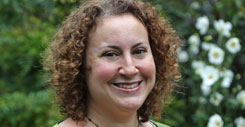
24 March 2021 – The built environment industry has a long way to go in order to break down the silos between practitioners and 'build better'. Dr Kayla Friedman, Course Director for the Sustainability Leadership for the Built Environment (IDBE) Master’s and Postgraduate Certificate, identifies the key change agents within the sector and outlines what they can do to catalyse the shift to sustainable project delivery.
Delivering a built environment project involves a wide range of professional groups including developers, architects, planners, engineers and contractors. However, a ‘silo mentality’ has developed within the industry leading to missed opportunities to integrate sustainability factors.
Combined with an antiquated system that fails to account for our modern nuanced and complex needs, we are left with a framework that desperately needs a major overhaul.
When you consider that every completed project has at least a 30-50 year lifespan in operational use and that the concrete industry has more emissions than aviation you start to see the importance of tackling the sustainability issue now. Decisions made today on energy and material use have long-term impacts at a time when broader society is struggling to address the climate emergency. We have an opportunity and a duty to change as an industry.
We need to start by examining the entire project lifecycle, assessing decision points along the way, sharing information and discoveries to help build a collective picture of how each project can achieve maximum impact. Yet we as an industry are consistently failing to engender collaborative working practices and as a result are not offering up collective solutions.
When I talk to professionals in the industry, it is clear they understand that their projects could be more sustainable and resilient but many either don’t have the deep knowledge or confidence required to adequately identify where changes can be made or, more significantly, the skills to implement the changes.
It is true the industry is starting to wake up to this disconnect with professionals across the board slowly adopting some of the technical skills required but this has also lead to increasing levels of frustration over why we’re not accelerating the shift to ‘build better’.
So who are the main change agents and what needs to be done?
There is a central role for the UK government to play in implementing regulatory, insurance and tax policies, as well as VAT exemptions, but this doesn’t appear to be one of their priority areas. Poor historic delivery of programmes like the Feed-in Tariff and Green Deal shouldn’t delay progress and the introduction of better incentives and enablers.
Professional bodies can contribute by advocating for change. It is important that this is carried out in collaboration with other professional associations. An inter-professional advisory group could oversee the revising of standard contracts, contracting terms and procurement policies. They could jointly advocate for and help to develop agreed metrics for performance monitoring, encourage communication and innovation, and processes for robust post occupancy reviews and evaluations to tackle the current constraints.
We also need to hear from their members. Organisations should conduct regular surveys to gauge current levels of engagement with sustainable project delivery, understand levels of technical knowledge and collate feedback on what members perceive as holding them back from delivering more sustainable outcomes.
In tandem, individuals can increase their effectiveness by taking action. Our part-time Sustainability Leadership for the Built Environment (IDBE) Master’s and Postgraduate Certificate uses a ground up approach where built environment professionals from a vast array of backgrounds learn what and where they can apply leverage to eradicate the silo approach, develop common terminology, effectively communicate and harmonise working practices to increase transparency and common understanding.
Within their day-to-day work environments, our students may be rigidly policed by their particular industry, as well as employer and project contracts. By offering a neutral learning environment in the classroom, these diverse groups collectively address projects, question motives and offer alternative solutions. It’s so important to facilitate interdisciplinary dialogue using real projects to make them aware of what is possible and hopefully inspire passion and innovation. We want them to feel they are not shackled by insurmountable constraints, and to develop skills that they can immediately take back into professional practice.
This interdisciplinary learning is what the industry desperately needs so that, like our students, they are equipped and confident to act as sustainability standard bearers enthusing their peer groups and colleagues to embrace change.
It’s encouraging that many of our graduates go on to adopt some of the practices they have learned at CISL within their own professional projects. Such single actions don’t mark a seismic shift that will revolutionise the built environment overnight but the movement is ever expanding.
It doesn’t matter what stage of this journey you’re on, embrace the future with confidence and don’t feel manipulated by the system - you are the new system.





